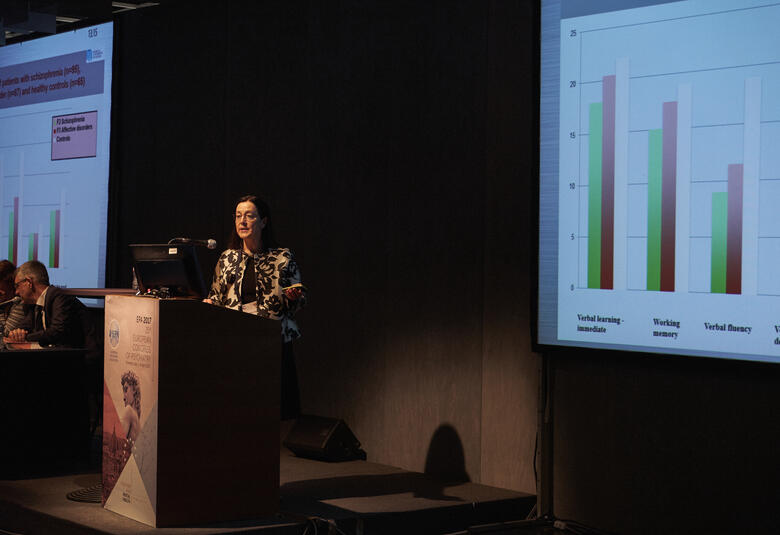Here we report the presentation given at SIRS 2016, Florence, Italy about how imaging techniques are being used to identify those at high risk of psychosis and those who might best respond to anti-psychotic medication following a first episode.
What is machine learning?
Machine learning is a process in which computer algorithms for learning, based on direct observation and experience, essentially enable predictions to be made based on what was experienced in the past. In the study of mental illness, machine learning has become a standard tool used in multivariate analyses to identify patterns of brain activity that will permit prediction of response or later prognosis.
Screening in adolescents
Using structural MRI data and trained support vector machines, it is possible to distinguish patients with either schizophrenia or bipolar disorder from healthy controls and from each other. Hugo Schnack, Utrecht, The Netherlands, wondered if it might also be possible to identify signs of disease in the adolescent offspring of those with either of these conditions, thereby identifying those most likely to experience psychosis.
High-risk adolescents identified with 70-81% accuracy
A longitudinal study is ongoing and baseline data are available. Using the adult algorithm that worked previously to separate those with schizophrenia and bipolar disorder from controls, separating high-risk adolescents from healthy controls was possible with 70-81% accuracy.
Can differentiate adolescents at risk for BP and schizophrenia
However, offspring at risk of schizophrenia and those at risk of bipolar disorder could not be separated from each other with any degree of certainty. It appears that the adult model is identifying brain abnormalities in at-risk subjects but that the tissue patterns are not necessarily the same as in adults with the corresponding conditions.
Accelerated brain aging in schizophrenia
To overcome this problem, an additional differentiating factor was clearly needed. The candidate factor selected was brain age. A longitudinal study using MRI brain scans taken at baseline, 1 year and 13 years showed that, in the schizophrenia brain, ageing accelerates over the duration of the illness at an average of 1.4 biological years per chronological year. However, this acceleration is not constant: it is greatest at time of onset of illness.
Brain age permits identification of at risk adolescents
Dr Schnack and his team have shown that adolescents at risk of schizophrenia can be separated from healthy controls on the basis of brain age. Following at-risk subjects to determine whether or not they develop psychosis is ongoing. The studies’ findings will hopefully permit detection of high-risk adolescents in the future.
Deconstructing volume
Children and adolescents with first-episode psychosis (FEP) and autism spectrum disorders (ASD) share neuroanatomical abnormalities. A previous study in which white and grey matter volumes were compared suggested there was no neuroanatomical overlap with either condition and control subjects. However, since then, cortical volume can be disassociated into cortical thickness and surface area (SA) so the components of volume can be independently assessed. Joost Janssen, Madrid, Spain, was interested in whether changes in these parameters were manifest in ASD and/or FEP and, if so, whether they were independent factors.
Comparisons of 29 cortical regions in three groups of adolescents (mean age 13 years) were compared: ASD, FEP and controls. Overlaps in neuroanatomical deficits were present in 3 regions in the brains of patients in the ASD and FEP groups. One affected region was the insula, a site where volume changes have been reported in other psychiatric conditions. Volume deficits were due more to decreased SA than cortical thickness, and changes in both appeared largely independent of each other. This suggests that two processes are driving corticogenesis, and both processes are affected in ASD and FEP.
Brain structural changes predict prognosis...
Paola Dazzan, London, UK, explained the importance of predicting prognosis at first psychotic episode in schizophrenia. Many patients respond well to anti-psychotic medication at first presentation but a significant proportion fail to ever respond. Definite alterations to brain structures are present prior to diagnosis in patients with schizophrenia. Therefore, she asked, could these structural changes be used to predict response to anti-psychotics at 12 weeks?
In schizophrenia, brain ageing accelerates at an average of 1.4 years per year
Brain structure was assessed in patients with FEP using MRI and diffusion tensor imaging All patients were followed for between 3 months and 6 years. A variety of neuroanatomical and morphological measures were assessed and then different uni- and multivariate analyses, including Support Vector Machines, were undertaken to spot consistent patterns of change. From these studies it was possible to distinguish those patients who would and would not respond to antipsychotic medications at 12 weeks with a high degree of confidence. Furthermore, these measure also related to prognosis over 6 years.
However, when Dr Dazzan’s lab collaborated with 5 other centres, expecting to be able to confirm and validate these findings, they found that they couldn’t. Why should this be?
What is ‘remission’?
The study was designed to examine the effect of anti-psychotics on remission. It appeared the 5 groups were each using different measurements of what counted as ‘remission’. Only London and a Brazilian lab used the same definition of remission – and when they did so the outcome predictions matched.
Environmental variables can make a difference
If the definition of remission is acting as a variable, what other variables might also affect outcome? Non-responders’ stress and immune responses to anti-psychotic medication appear to be different. Such effects are likely to influence outcomes. Use of cannabis also influences how well a patient is likely to respond – high rates of cannabis use are associated with poorer outcomes as are high rates of smoking. Patients with schizophrenia are heterogeneous and when trying to stratify this population for a likely prognosis with any degree of certainty, external, environmental interactions must be considered.


